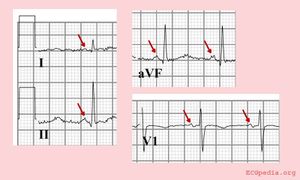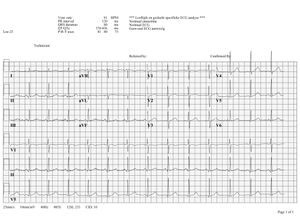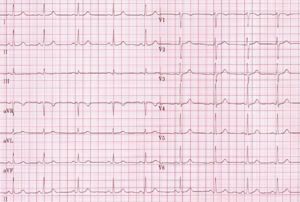P Wave Morphology: Difference between revisions
Jump to navigation
Jump to search
No edit summary |
mNo edit summary |
||
| Line 21: | Line 21: | ||
[[Image:Normaal ecg.jpg|thumb| An example of normal sinus rhythm.]] | [[Image:Normaal ecg.jpg|thumb| An example of normal sinus rhythm.]] | ||
[[Image:Nsr.jpg|thumb| Another example of normal sinus rhythm.]] | [[Image:Nsr.jpg|thumb| Another example of normal sinus rhythm.]] | ||
Characteristics of a normal p wave:<cite>Spodick</cite> | {| class="Wikitable" | ||
! Characteristics of a normal p wave:<cite>Spodick</cite> | |||
|- | |||
| | |||
*The maximal height of the P wave is 2.5 mm in leads II and / or III | *The maximal height of the P wave is 2.5 mm in leads II and / or III | ||
*The p wave is positive in II and AVF, and bifasic in V1 | *The p wave is positive in II and AVF, and bifasic in V1 | ||
*The p wave duration is usually shorter than 0.12 seconds | *The p wave duration is usually shorter than 0.12 seconds | ||
|} | |||
Elevation or depression of the [[PTa segment]] (the part between the p wave and the beginning of the QRS complex) can result from [[Ischemia#Atrial infarction|Atrial infarction]] or [[Clinical Disorders#Pericarditis|pericarditis]]. | Elevation or depression of the [[PTa segment]] (the part between the p wave and the beginning of the QRS complex) can result from [[Ischemia#Atrial infarction|Atrial infarction]] or [[Clinical Disorders#Pericarditis|pericarditis]]. | ||
Revision as of 22:35, 5 January 2008
| «Step 4:Heart axis | Step 6: QRS morphology» |
| Author(s) | J.S.S.G. de Jong, MD | |
| Moderator | J.S.S.G. de Jong, MD | |
| Supervisor | ||
| some notes about authorship | ||
The p wave morphology can reveal right or left atrial stretch.
The P-wave morphology is best determined in leads II and V1 during sinus rhythm.
The normal P wave
| Characteristics of a normal p wave:[1] |
|---|
|
Elevation or depression of the PTa segment (the part between the p wave and the beginning of the QRS complex) can result from Atrial infarction or pericarditis.
If the p-wave is enlarged, the atria are enlarged.


